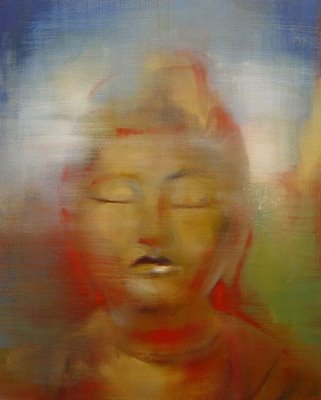
"Artists are mystics rather than rationalists. They leap to conclusions that logic cannot reach."
--Sol LeWitt, 1969
Sol LeWitt's retrospective, which ran from February 19, 2000 - May 21, 2000 at the San Francisco Museum of Modern Art was a revelation. The timing of the exhibition was deeply personal for me. It was the end of one phase of my life, an introduction to a new path, and ultimately a springboard -both personally and artistically- to a new world.
Sol LeWitt's life work as laid out in SFMOMA's exhibition was intellectually stimulating and ravishingly beautiful. This was an artist who was deeply serious, yet who had no fear of beauty.

Sol LeWitt
"Cube-Circle 4"
wall drawing
from Sol LeWitt: New Wall Drawings & Photographs at the Fraenkel Gallery, San Francisco which ran from Sep 9 - Oct 30, 2004
"I would like to produce something I would not be ashamed to show Giotto."
--Sol LeWitt, 1980's
"Born in 1928 in Hartford, Connecticut, LeWitt moved to New York in 1953, just as Abstract Expressionism was beginning to gain public recognition and was dominating contemporary art. He found various jobs to support himself, first in the design department at Seventeen magazine, doing paste-ups, mechanicals, and photostats, and later, for the young architect I.M. Pei as a graphic designer. This contact proved formative, for as LeWitt would later write, "an architect doesn't go off with a shovel and dig his foundation and lay every brick. He's still an artist."
-from the SFMOMA website created for the Sol LeWitt retrospective which ran from February 19, 2000 - May 21, 2000.
Sol LeWitt at SFMOMA
Sol LeWitt
Wall Drawing at Crown Point Press, 657 Howard St Entrance.
Sol LeWitt's essay "Paragraphs on Conceptual Art", from 1967, provided a clear explanation of his artistic aims:
"No matter what form it may finally have it must begin with an idea."
"When an artist uses a conceptual form of art, it means that all of the planning and decisions are made beforehand and the execution is a perfunctory affair. The idea becomes a machine that makes the art."
The SFMOMA site on the Sol LeWitt exhibition explains, "In 1960 LeWitt took a job at The Museum of Modern Art, working first at the book counter and later as a night receptionist. He met other young artists working there (Dan Flavin, Robert Mangold, Robert Ryman, and Scott Burton), placing him in the midst of a community of young artists searching for a new direction."
Other artists were important to Sol LeWitt. As
Tyler Green points out: "Stories of LeWitt's generosity to other artists and to the art world are everywhere. In addition to supporting groups such as Printed Matter, for years LeWitt traded work with near any artist who wanted to trade with him. He kept the works he received in a warehouse near his home, in Chester, Conn. He sent his collection of contemporary art around the country, mostly to small museums that have limited access to top new art."
LeWitt most often used assistants to execute the works based upon his detailed instructions.
Below are LeWitt's instructions for the execution of Wall Drawing #340, 1980:
"Six-part drawing. The wall is divided horizontally and vertically into six equal parts. 1st part: On red, blue horizontal parallel lines, and in the center, a circle within which are yellow vertical parallel lines; 2nd part: On yellow, red horizontal parallel lines, and in the center, a square within which are blue vertical parallel lines; 3rd part: On blue, yellow horizontal parallel lines, and in the center, a triangle within which are red vertical parallel lines; 4th part: On red, yellow horizontal parallel lines, and in the center, a rectangle within which are blue vertical parallel lines; 5th part: On yellow, blue horizontal parallel lines, and in the center, a trapezoid within which are red vertical parallel lines; 6th part: On blue, red horizontal parallel lines, and in the center, a parallelogram within which are yellow vertical parallel lines. The horizontal lines do not enter the figures."
.jpg)
Sol LeWitt Wall Drawing in the Lobby at SFMOMA
LeWitt's work strikes a delicate balance between the physical work and the idea. His wall drawings begin with a series of mathematical calculations laid out on papers, which are crafted into precise yet open instructions that a team of collaborators executes.
LeWitt's massive, vibrant wall drawings are like Renaissance frescoes in their ability to create a new kind of space which is both painting and architecture.

Sol LeWitt Wall Drawing in the Lobby at SFMOMA
Even though LeWitt used industrial materials that he felt would erase any trace of craft and employed assistants to execute his ideas, the importance of the artist's hand is still evident in the subtle shifts in color and line in the wall drawings. LeWitt's desire to adhere to a system did not negate his wish to create truly beautiful wall drawings. As the artist said in the early 1980s, "I would like to produce something I would not be ashamed to show Giotto."
More at:
Tyler GreenVideo: Sol LeWitt Makes a Drawing from SFMOMA*
*The interactive media works created by SFMOMA'S education department are consistently remarkable. Artist,
Tim Svenonius, is deeply involved in many of these projects, including his work on the groundbreaking discovery of an early
Picasso found hidden under SFMOMA's "Street Scene" painted by Picasso in 1900

Hidden Picasso Under SFMOMA's "Street Scene" painted by Picasso in 1900.
Interactive Site: SFMOMA's Hidden Picasso Tim Svenonius Site
Painting in SFMOMA lobby
photo by Clay Vajgrt












.jpg)

































